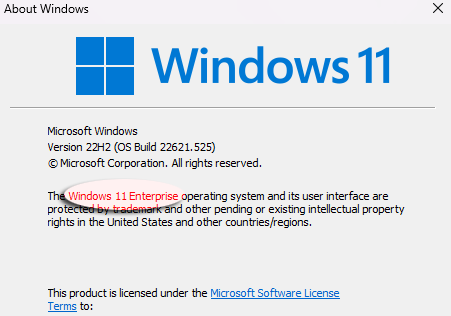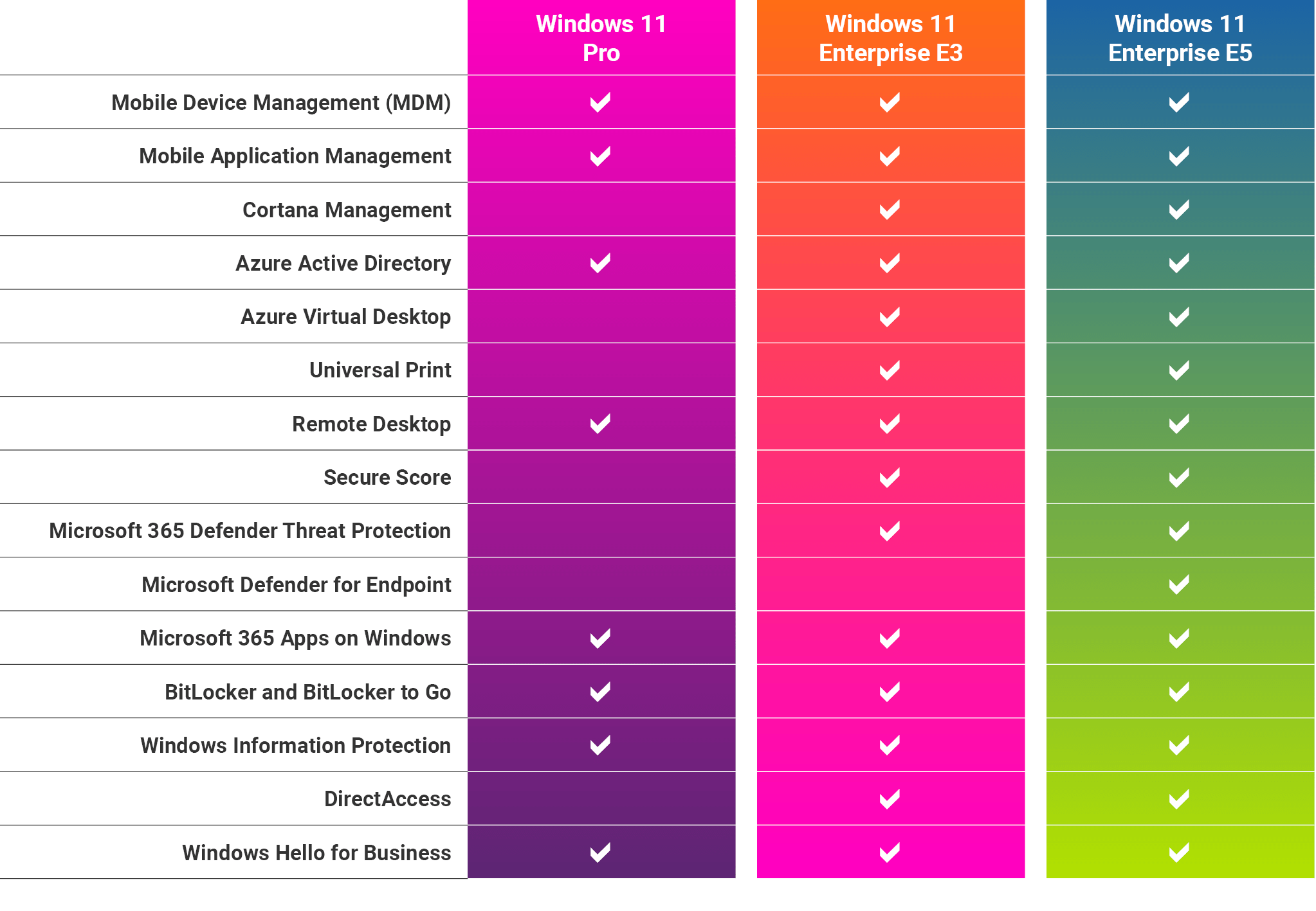You’d think, given the title of this page, I might list some differences in these Windows 11 version. Well, I might update this thing but for the moment I’m just making a couple of notes based upon a few random observations.
The differences I have found – and what is this “N” thing?
First, why are there options at install for “Enterprise” and “Pro”, and, “Enterprise N” and “Pro N”. Per the web the versions with the “N” at the end do not include some media components. By the way, I downloaded a couple of installer discs and, unlike the graphic on this page, the only options I’ve seen for install are Enterprise and Pro.
By the way, to check which version have installed press the Windows key + R and type “winver”. You’ll get this pop up:

Some differences I’ve noticed: With the Enterprise version you log in with a password and with the Pro version you create a PIN number. Also, the Pro version has kind of a fancy feature the pops up when you press the PrintScreen button….allows you to select an area. During install, too, with the Enterprise version you are not offered the option to create a local account, exactly – you are offered the option to “Join a domain” which amounts to the same thing.
Summary: Ain’t a lot to say. I use Linux 96-percent of the time and I can’t see much difference in these two versions. If a person uses Windows a lot I’m sure that some of the differences are of consquence. I’m messing around with Windows, and, once in awhile using a Windows application – that’s it. I downloaded some .iso files from a bit torrent site and they came with crack tool. Microsoft is losing nothing, in my case, since I almost never use this OS and they’re still making money by showing me ads, tracking my web surfing habits, etc.
Since I’m really not a Windows kinda guy these differences, as I’ve explained, are of little consequence in my case – although I tend to prefer the Pro version. Here’s a chart of the differnces:

Removing Bloatware (tool)
You can download this tool, here, but I am nervous about running the thing and it’s something which I’ve not tested. The version on this page was downloaded March 8th, 2024.
Tool Features
Default Settings
- Remove the default selection of bloatware apps from this list.
- Disable telemetry, diagnostic data, app-launch tracking & targeted ads.
- Disable & remove bing search & cortana in Windows search.
- Disable tips, tricks, suggestions and ads in start, settings, notifications, Windows explorer, and on the lockscreen.
- Disable Windows Copilot. (Windows 11 only)
- Show file extensions for known file types.
- Disable the widget service & hide the icon from the taskbar.
- Hide the Chat (meet now) icon from the taskbar.
- Hide the 3D objects folder under ‘This pc’ in Windows explorer. (Windows 10 only)
All Features
- Remove bloatware apps, with the option to select exactly what apps to remove or keep.
- Remove all pinned apps from the start menu. NOTE: This applies to all existing and new users. (Windows 11 only)
- Disable telemetry, diagnostic data, app-launch tracking & targeted ads.
- Disable & remove bing search & cortana in Windows search.
- Disable tips, tricks, suggestions and ads in start, settings, notifications, Windows explorer, and on the lockscreen.
- Disable Windows Copilot. (Windows 11 only)
- Restore the old Windows 10 style context menu. (Windows 11 only)
- Show hidden files, folders and drives.
- Show file extensions for known file types.
- Hide duplicate removable drive entries from the Windows explorer navigation pane, so only the entry under ‘This PC’ remains.
- Align taskbar icons to the left. (Windows 11 only)
- Hide or change the search icon/box on the taskbar. (Windows 11 only)
- Hide the taskview button from the taskbar. (Windows 11 only)
- Disable the widget service & hide icon from the taskbar.
- Hide the chat (meet now) icon from the taskbar.
- Hide the 3D objects, music or onedrive folder in the Windows explorer sidepanel. (Windows 10 only)
- Hide the ‘Include in library’, ‘Give access to’ and ‘Share’ options in the context menu. (Windows 10 only)
Tip
In ‘custom mode’ you can specify exactly which apps you like to remove and which you want to keep!
Warning
Great care went into making sure this script does not break any OS functionality, but use at your own risk!
Easy method
- Download the latest version of the script, and extract the .ZIP file to your desired location.
- Navigate to the Win11Debloat folder
- Double click the ‘Run.bat’ file to start the script. Note: If the console window immediately closes and nothing happens, try the advanced method below.
- Accept the Windows UAC prompt to run the script as administrator, this is required for the script to function.
- A new powershell window will now open, showing the Win11Debloat menu. Select either the default or custom mode to continue.
- Carefully read through and follow the on-screen instructions.
After making the selected changes the Win11Debloat script will restart the Windows Explorer process to properly apply them. If Windows Explorer does not recover after running the script and your desktop stays black, don’t worry. Just press Ctrl + Alt + Del to restart your PC.
Advanced method
This method gives you the option to run the script with certain parameters to tailor the behaviour of the script to your needs and it allows you to run the script without requiring any user input during runtime, making it quicker and easier to deploy on a large number of systems.
- Download the latest version of the script, and extract the .ZIP file to your desired location.
- Open powershell as an administrator.
- Enable powershell execution by entering the following command:
Set-ExecutionPolicy Unrestricted -Scope Process - In powershell, navigate to the directory where the files were extracted. Example:
cd c:\Win11Debloat - Enter this into powershell to run the script:
.\Win11Debloat.ps1 - The Win11Debloat menu will now open. Select either the default or custom setup to continue.
To run the script without any user input, simply add parameters at the end, example: .\Win11Debloat.ps1 -RemoveApps -DisableBing -Silent
| Parameter | Description |
|---|---|
| -Silent | Suppresses all interactive prompts, so the script will run without requiring any user input. |
| -RunDefaults | Run the script with the default settings. |
| -RemoveApps | Remove all bloatware apps from this list. |
| -RemoveCommApps | Remove the Mail, Calender, and People apps. |
| -RemoveW11Outlook | Remove the new Outlook for Windows app. |
| -RemoveDevApps | Remove developer-related apps such as Remote Desktop, DevHome and Power Automate. |
| -RemoveGamingApps | Remove the Xbox App and Xbox Gamebar. |
| -ClearStart | Remove all pinned apps from the start menu. NOTE: This applies to all existing and new users. (Windows 11 update 22H2 or later only) |
| -DisableTelemetry | Disable telemetry, diagnostic data & targeted ads. |
| -DisableBing | Disable & remove bing search, bing AI & cortana in Windows search. |
| -DisableSuggestions | Disable tips, tricks, suggestions and ads in start, settings, notifications and Windows explorer. |
-DisableLockscreenTips |
Disable tips & tricks on the lockscreen. |
| -RevertContextMenu | Restore the old Windows 10 style context menu. (Windows 11 only) |
| -ShowHiddenFolders | Show hidden files, folders and drives. |
| -ShowKnownFileExt | Show file extensions for known file types. |
| -HideDupliDrive | Hide duplicate removable drive entries from the Windows explorer navigation pane, so only the entry under ‘This PC’ remains. |
| -TaskbarAlignLeft | Align taskbar icons to the left. (Windows 11 only) |
| -HideSearchTb | Hide search icon from the taskbar. (Windows 11 only) |
| -ShowSearchIconTb | Show search icon on the taskbar. (Windows 11 only) |
| -ShowSearchLabelTb | Show search icon with label on the taskbar. (Windows 11 only) |
| -ShowSearchBoxTb | Show search box on the taskbar. (Windows 11 only) |
| -HideTaskview | Hide the taskview button from the taskbar. (Windows 11 only) |
| -DisableCopilot | Disable Windows copilot. (Windows 11 only) |
| -DisableWidgets | Disable the widget service & hide the widget (news and interests) icon from the taskbar. |
| -HideChat | Hide the chat (meet now) icon from the taskbar. |
| -HideOnedrive | Hide the onedrive folder in the Windows explorer sidepanel. (Windows 10 only) |
| -Hide3dObjects | Hide the 3D objects folder under ‘This pc’ in Windows explorer. (Windows 10 only) |
| -HideMusic | Hide the music folder under ‘This pc’ in Windows explorer. (Windows 10 only) |
| -HideIncludeInLibrary | Hide the ‘Include in library’ option in the context menu. (Windows 10 only) |
| -HideGiveAccessTo | Hide the ‘Give access to’ option in the context menu. (Windows 10 only) |
| -HideShare | Hide the ‘Share’ option in the context menu. (Windows 10 only) |
